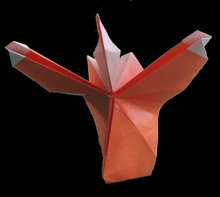
We already said that main source for cellulose is treewood. Also saw that together with cellulose other elements coexists in plant's cells, like Hemilcellulose and Lignin. However, reading this book I've learned that Lignin works as a binding agent between fibers and that its concentration grows in the outer layers of the cell, contrary to what I said in the previous entry. In fact, it is necessary to remove lignin to free the fibers in an homogeneous solution, since it concentrates on the outer walls of the fiber isolating it from others, reducing the number of possible contact points between them (which are what generates the "bond" characteristic of paper). Lignin has a very complex and variable chemical structure, it is insoluble in water but can be disolved on certain acids solutions.
As a tip to whom desires to cook their own pulp, an agent that disolves lignin (not very efficiently but it works) is popular caustic soda in water. Its efficiency improves in pressence of high temperatures and pressure (but to use a pressure cooker with caustic soda is extremely dangerous!). Do not worry about cellulose, its chemical binding is strong enough to all acids except a few number of strong ones.
The other component, Hemilcellulose, is a polymer similar to cellulose but with slightly different molecular arrangements; is important in paper since it stimulates creation of fibre to fibre contacts and in its water absorption hability, however, it doesn't resist the lignin elimination process.


Also because the fact that papermaking from tree wood has become an extremely contaminant process just for the use of chemicals in the removal of lignin, and it is in that way because the low costs induced by wood and the chemical usage. Among the ways to produce cellulose there is the pure mechanical (as stone groundwood and Refiner Mechanical Pulp), constituting 10-15% of world's paper production, their disadvantages are the difficulties to obtain an uniform and homogeneous pulp, the breaking and damaging of fibres and paper's short lifetime, reasons because it is used mainly for newspapers, catalogs and light publications.
Lignin gives paper and pulp a characteristic brown color. It's important to understand that is impossible to remove all lignin from pulp, so all pulps coming from tree wood have that characteristic before the bleaching process; kraft paper has that colour only to the absence of the bleaching stage and it is a pure chemical pulp process.
As we talk about pollution, the whole process of papermaking is extremely water and energy consuming and, even when enormous advances has been developed in the reusage of water and chemicals to reduce that fact, it is far away from being reasonable for nature., all that leads us to the need of minimize the use of paper in our regular life and to respect and love the piece of paper we hold in hands, because the cost and sacrifice that it meant.
Grammage
Formation
Thickness
Directionality
Two-sidedness
Smoothness
Porosity
Grammage
In industrial terms, weight of paper is measured by fixed packages of a given number of sheets and standard sizes for them, which makes thorny and difficult to make any comparative analysis between different kinds of paper; for that reason, the International System of Measurements (SI) established the mass content in a single sheet of known area, or grammage (grams per square meter, g/m2) as the mass - characterizing value for paper.
Typical values of grammage for paper are:

Formation on paper refers to uniformity in the distribution of the fibres and other components along and wide the sheet of paper; it is in the pulp sheet making stage when this is controlled.
Thickness
Thickness (or Caliper) is a vital parameter but commonly undervalued by designers and folders, who normally looks for the thinness possible piece of paper to its much complex models, specially for the box-pleated ones. There is a tendency to believe that thickness of paper is negligible and it will not affect the geometry and symmetry of the figure, nothing further from reality, specially when folding lots of layers together.
It is obvious that the maximum number of layers to be folded together is related with the thickness of the paper. However, there is a physical limit that show us to understand the real importance of it when folding any sheet. To illustrate it let's exaggerate the thicknes and see how many layers creates long and wide concentric circumferences around the fold; the long the number of them, greater the amount of paper they take away from the model.


She achieved a world record folding a sheet over itself a number of 12 times (for curiouses our bond paper should be 880 meters!!, nearly a kilometre!).
Regular values for thickness are given in the next table:





2 comments:
haha
are the wantons so funny?
by the way, nice to meet you.
i just posted the spider to fill the gap because i wont be updating so soon due to exams this whole month..
pls visit back !i have 2 ideas for the next design.
p/s: by the way, have you try folding a piece of paper into half 12 times?
Hi Steyen,
no way! hahaha I'm not so crazy to try it. But is an important fact for box-pleating lovers and their 20-layered legs :D
I'll visit you regullarly
greetings.
Post a Comment